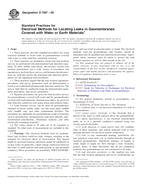Potřebujeme váš souhlas k využití jednotlivých dat, aby se vám mimo jiné mohly ukazovat informace týkající se vašich zájmů. Souhlas udělíte kliknutím na tlačítko „OK“.
ASTM D7007-09
Standard Practices for Electrical Methods for Locating Leaks in Geomembranes Covered with Water or Earth Materials
Automaticky přeložený název:
Standardní postupy pro elektrické metody pro vodicí Úniky v geomembranes pokryt vodou nebo zeminy Materiály
NORMA vydána dne 1.6.2009
Informace o normě:
Označení normy: ASTM D7007-09
Poznámka: NEPLATNÁ
Datum vydání normy: 1.6.2009
Kód zboží: NS-37279
Počet stran: 12
Přibližná hmotnost: 36 g (0.08 liber)
Země: Americká technická norma
Kategorie: Technické normy ASTM
Anotace textu normy ASTM D7007-09 :
Keywords:
construction quality assurance, electrical leak location method, geomembrane, leak detection, leak location, Construction quality assurance, Earth coverings, Electrical leak location, Geomembranes, Leak testing--geosynthetics, Moisture analysis--geosynthetics, ICS Number Code 59.080.70 (Geotextiles)
Doplňující informace
| Significance and Use | ||||
|
Geomembranes are used as impermeable barriers to prevent liquids from leaking from landfills, ponds, and other containments. The liquids may contain contaminants that if released can cause damage to the environment. Leaking liquids can erode the subgrade, causing further damage. Leakage can result in product loss or otherwise prevent the installation from performing its intended containment purpose. For these reasons, it is desirable that the geomembrane have as little leakage as practical. Geomembrane leaks can be caused by poor quality of the subgrade, poor quality of the material placed on the geomembrane, accidents, poor workmanship, and carelessness. The most significant causes of leaks in geomembranes that are covered with only water are related to construction activities including pumps and equipment placed on the geomembrane, accidental punctures, and punctures caused by traffic over rocks or debris on the geomembrane or in the subgrade. The most significant cause of leaks in geomembranes covered with earth materials is construction damage caused by machinery that occurs while placing the earth material on the geomembrane. Such damage also can breach additional layers of the lining system such as geosynthetic clay liners. Electrical leak location methods are an effective final quality assurance measure to locate previously undetected or missed leaks. |
||||
| 1. Scope | ||||
|
1.1 These practices describe standard procedures for using electrical methods to locate leaks in geomembranes covered with water or earth materials containing moisture. 1.2 These practices are intended to ensure that leak location surveys are performed with demonstrated leak detection capability. To allow further innovations, and because various leak location practitioners use a wide variety of procedures and equipment to perform these surveys, performance-based operations are used that specify the minimum leak detection performance for the equipment and procedures. 1.3 These practices require that the leak location equipment, procedures, and survey parameters used are demonstrated to result in an established minimum leak detection sensitivity. The survey shall then be conducted using the demonstrated equipment, procedures, and survey parameters. 1.4 Separate procedures are given for leak location surveys for geomembranes covered with water and for geomembranes covered with earth materials. Separate procedures are given for leak detection sensitivity tests using actual and artificial leaks. 1.5 Leak location surveys can be used on geomembranes installed in basins, ponds, tanks, ore and waste pads, landfill cells, landfill caps, and other containment facilities. The procedures are applicable for geomembranes made of materials such as polyethylene, polypropylene, polyvinyl chloride, chlorosulfonated polyethylene, bituminous material, and other electrically-insulating materials. 1.6 The values stated in SI units are to be regarded as standard. No other units of measurement are included in this standard. 1.7 Warning—The electrical methods used for geomembrane leak location could use high voltages, resulting in the potential for electrical shock or electrocution. This hazard might be increased because operations might be conducted in or near water. In particular, a high voltage could exist between the water or earth material and earth ground, or any grounded conductor. These procedures are potentially VERY DANGEROUS, and can result in personal injury or death. The electrical methods used for geomembrane leak location should be attempted only by qualified and experienced personnel. Appropriate safety measures must be taken to protect the leak location operators as well as other people at the site. 1.8 This standard does not purport to address all of the safety concerns, if any, associated with its use. It is the responsibility of the user of this standard to establish appropriate safety and health practices and determine the applicability of regulatory limitations prior to use. |
||||
| 2. Referenced Documents | ||||
|




 Cookies
Cookies
